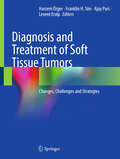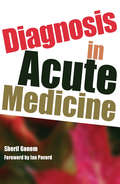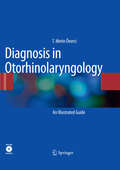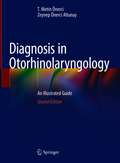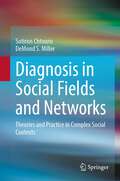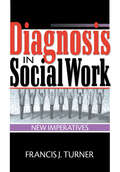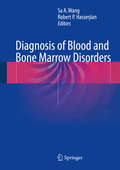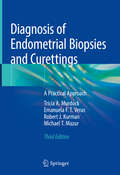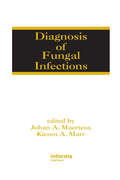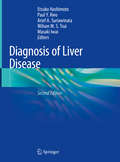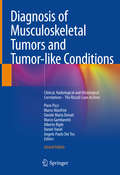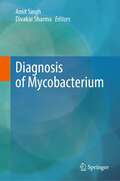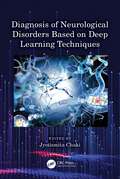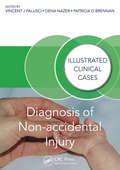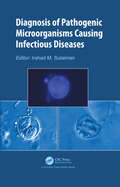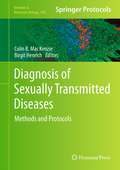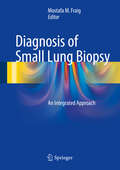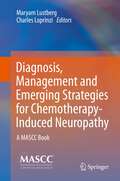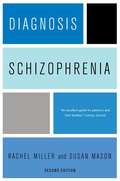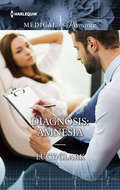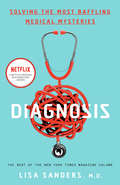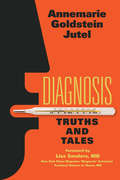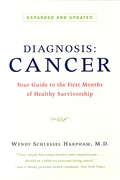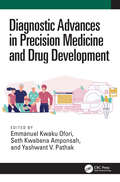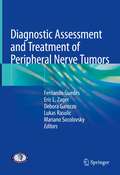- Table View
- List View
Diagnosis and Treatment of Soft Tissue Tumors: Changes, Challenges and Strategies
by Levent Eralp Franklin H. Sim Harzem Özger Ajay PuriThis book offers a comprehensive overview of both diagnosis and treatment of soft tissue tumors, ranging from imaging and pathological work-up to non-surgical treatment options and limb salvage surgery. In the first part readers will learn currents concepts, controversial areas and future perspectives in the classification, diagnostics and treatment of soft tissue tumors. The second part is entirely devoted to the presentation of several clinical cases grouped together by anatomical region. On the whole, this work not only shares the most up-to-date knowledge but also envisions a more philosophical and in-depth approach to this challenging group of tumors. Written by internationally renowned experts in the field, this volume is a must-read for senior orthopedic surgery residents, orthopedic oncology fellows and orthopedic oncologists. It will further appeal to musculoskeletal pathologists and radiologists as well as clinical, pediatric and radiation oncologists, wishing to deepening their knowledge of soft tissue tumors.
Diagnosis in Acute Medicine
by Sherif GonemUndergraduate and postgraduate teaching increasingly favours a symptom-based approach to diagnosis. Unlike many other textbooks in acute medicine, this book reflects this shift in emphasis, presenting a logical and structured approach to the diagnosis and initial management of acutely unwell adults. It discusses the relevant pathophysiology of each clinical presentation, and provides a comprehensive table of differential diagnoses, highlighting common causes. The book's description of generic emergency management emphasises important diagnoses, and explains relevant history, examination findings and investigations involved in assessment or diagnosis. Senior medical students and junior doctors in their first four years after qualifying will find this an invaluable aid to honing their clinical practice. The logical systems of diagnostic thought will serve them throughout their careers. No book can replace hard work on the ward and in clinics but books can speed up the acquisition of skills by fostering sound basic principles and developing the right instincts. Diagnosis in Acute Medicine is particularly helpful in this regard. I strongly recommend it.A " - From the Foreword by Ian Pavord
Diagnosis in Otorhinolaryngology
by T. Metin ÖnerciWhen making a diagnosis it is of paramount importance that the ear, nose and throat (ENT) specialist views the lesion and recognizes its pathology. Significant technological advances have enabled diseases to be imaged and documented. Using these images, this book targets beginners (residents, general practitioners, nurses, and students) as well as experts who would like to improve and teach their skills. It provides specialists with an unprecedented opportunity to use unique pictures and schematic drawings as part of their presentations. A DVD with all illustrations is included for teaching purposes.
Diagnosis in Otorhinolaryngology: An Illustrated Guide
by T. Metin Önerci Zeynep Önerci AltunayThis revised and expanded second edition provides a comprehensive and up-to-date pictorial overview of the majority of ENT conditions. When making a diagnosis, it is of paramount importance that the ear, nose and throat (ENT) specialist views the lesion and recognizes its pathology. Recent advances in endoscopic technology have enabled us to obtain clear images of such lesions and have changed our approach to diseases and techniques in the fields of ENT and head and neck surgery. Featuring schematic drawings to make difficult topics more understandable, the book supports beginners in their search for the correct diagnosis, and increases their understanding of basic surgical approaches. It provides fundamental information required for diagnosis and treatment in an easily accessible form, while the tables, photographs and schematic drawings allow readers to grasp the problems quickly. It is also a useful guide for all experts involved in teaching diagnostic and surgical skills. Diagnosis in Otorhinolaryngology 2nd Edition is intended for general practitioners, medical students and ENT trainees, fellows, academicians and teachers.
Diagnosis in Social Fields and Networks: Theories and Practice in Complex Social Contexts
by DeMond S. Miller Sotirios ChtourisContaining a novel compilation of theoretical and methodological approaches, this textbook lays out the most relevant foundations of clinical sociology. Relying heavily on well-recognized medical models and concepts to help communicate ideas (e.g. treatment, diagnosis, clinical, cure), the methods of social diagnosis and social therapy presented in this book will help in better and socially informed protection of vulnerable individuals and citizens as well as an informed design of protection policies for macro, meso and micro levels of society. The book explains that many problems, perceived as economic, psychological-individual, and political, are rooted in social functions and structures of the wider society, and how these social structures and functions interact in everyday life. Through the application of the theoretical and methodological approaches in case studies on recent issues, such as the Covid pandemic, or the Hurricane Katrina disaster, the book will allow readers to easily cope with the complexity of clinical sociology and to develop clinical competencies and pertinent training. This renders the book not only highly useful for advanced undergraduate and graduate students of clinical and applied sociology but also for the preparation of courses for theoretically informed practitioners who are keen to work by defining learning objectives and learning paths.
Diagnosis in Social Work: New Imperatives
by Francis J TurnerHow can you make necessary professional judgments without being judgmental?Assessment and diagnostic skills are essential professional tools for the social worker, but all too often they are neglected or downplayed. Diagnosis in Social Work argues for the reinstatement of social diagnosis to its former place as an essential concept in social work. This courageous book demonstrates the detrimental impact of the loss of diagnostic skills on the quality of social work intervention.Combining meticulous history with insightful analysis, Diagnosis in Social Work shows how the concept of diagnosis in social work has been misunderstood. It examines the negative, narrow definition of diagnosis offered in commonly used texts. Diagnosis in Social Work includes the tools you need to use the power of correct, careful diagnosis, including: case examples of social work diagnoses a thorough profile of the judgments constituting a social work diagnosis suggestions to enhance diagnostic acumen an analysis of diagnosis as a process and a fact ways to use computers in diagnosis an assessment of the risks of diagnosisDiagnosis in Social Work includes everything social work practitioners need to know about the process and meaning of this sorely neglected part of the field. It is an ideal textbook as well, and it offers suggestions for further research.
Diagnosis of Blood and Bone Marrow Disorders
by Sa A. Wang Robert P. HasserjianThis book focuses on hematopoietic and lymphoid neoplasms that initially present as peripheral blood abnormalities, with either cytopenias or elevated peripheral blood counts, as well as non-neoplastic conditions that may raise concern for a hematologic malignancy. The scope of the book includes myelodysplastic syndromes (MDS), myeloproliferative neoplasms (MPN), mixed myelodysplastic/myeloproliferative neoplasms (MDS/MPN), as well as lymphomas and lymphoid leukemias that typically present initially with peripheral blood abnormalities. Within each category, a comprehensive list of differential diagnoses is discussed. For each disease entity, the reader is updated with new molecular genetic data, biomarkers, and recent applications of immunophenotyping, and how to incorporate the new information in disease diagnosis and classifications is illustrated, including the use of diagnostic algorithms where appropriate. The book employs the revised WHO Classification of Hematopoietic Neoplasms for all disease entities. Diagnosis of Blood and Bone Marrow Disorders will serve as a very useful resource for pathologists, pathologists in training, hematologists and medical technologists who are involved in the clinical work-up of patients with bone marrow and blood neoplasms. It will provide a practical and concise yet comprehensive review.
Diagnosis of Endometrial Biopsies and Curettings: A Practical Approach
by Robert J. Kurman Tricia A. Murdock Michael T. Mazur Emanuela F.T. VerasDerived from the authors' long-running course presented at the International Academy of Pathology, this second edition, now with color illustrations, continues the tradition of its predecessor as being the concise and complete diagnostic guide to the endometrial biopsy. The text is structured so as to present a logical approach to formulating a pathologic diagnosis from the diverse array of tissue received in the surgical pathology laboratory. Color illustrations show typical artifacts and distortion, and explain their impact on diagnostic interpretation. Each chapter includes a section summarizing the features that must be discussed in the final pathology report.
Diagnosis of Fungal Infections
by Johan Maertens Kieren A. MarrAnalyzing a key cause of infectious morbidity in immunosuppressed and immunocompromised patients, this source spans the most recent strategies to improve and expedite the diagnosis, identification, and treatment of fungal infections. With authoritative contributions from experienced clinicians in the field, this reference tracks developments in ima
Diagnosis of Liver Disease
by Etsuko Hashimoto Paul Y. Kwo Arief A. Suriawinata Wilson M. S. Tsui Masaki IwaiThis book guides practitioners in the assessment of patients with a liver problem. The emphasis is on the role of macro- and microscopic pathology in elucidating pathogenesis as well as identifying confounding features of image findings that may lead to a more elaborate differential diagnosis. If appropriate, the role of light and electron microscopic examination, along with the role of specific stains and molecular techniques, is illustrated. In addition, the concept of each liver disease is summarized briefly and its up-to-data is provided, and unresolved problems in diagnosis, treatment, and pathogenesis are clearly described.The approach in this book is a practical one with a focus on the evaluation of illustrative cases, simultaneously demonstrating cross-sectional images (ultrasonography, computed tomography, magnetic resonance imaging, and angiography), pathological findings, and peritoneoscopic images. The diagnosis and therapy are summed up in helpful tables, and association of clinical manifestations with image analysis and pathological findings is shown to be important in differential diagnosis and treatment. With the authors comprising internationally renowned experts, this book will serve as a useful source of information for medical students, physicians, internists, hepatologists, gastroenterologists, radiologists, and pathologists worldwide.
Diagnosis of Musculoskeletal Tumors and Tumor-like Conditions: Clinical, Radiological and Histological Correlations - The Rizzoli Case Archive
by Piero Picci Marco Manfrini Marco Gambarotti Daniel Vanel Davide Maria Donati Alberto Righi Angelo Paolo Dei TosThis book, now in a second revised edition, casts light on the often complex diagnosis of musculoskeletal tumors and tumor-like conditions by drawing on the experience of the Rizzoli Orthopedic Institute during more than 100 years of treatment and research in the field. The different entities are described from a multidisciplinary perspective, highlighting clinical, radiological, and histological correlations. Particular emphasis is placed on differential diagnosis, which often needs to take into account nontumoral conditions. The recent identification of further significant biological and genetic features, and the impact of these discoveries on the classification of round cell tumors, vascular lesions, and spindle/pleomorphic entities in bone, is also extensively discussed. The Rizzoli case archive dates back to September 1900 and contains the original material relating to more than 29,000 bone lesions and 11,000 soft tissue lesions. It is a fabulously rich resource, and this book will be invaluable for pathologists, radiologists, and clinicians at all levels of experience.
Diagnosis of Mycobacterium
by Amit Singh Divakar SharmaThis book covers all the aspects related to the laboratory diagnosis of Mycobacterium. Laboratory diagnosis includes microscopic to advance molecular diagnosis. Moreover, it deals with the methods used to detect antimycobacterial susceptibility tests and drug resistance. Chapters cover most potential methods and techniques from traditional to advanced future diagnostics for identifying tuberculosis, NTM, and latent TB infections. Also discussed the challenges and opportunities in the diagnostic science of infectious disease. This book offers assistance to students, postgraduate medical students, researchers, medical practitioners, postdoctoral fellows, microbiologists, nurses, and public health officers working in tuberculosis control programs to understand various modalities for diagnosis and drug-resistance tuberculosis.
Diagnosis of Neurological Disorders Based on Deep Learning Techniques
by Jyotismita ChakiThis book is based on deep learning approaches used for the diagnosis of neurological disorders, including basics of deep learning algorithms using diagrams, data tables, and practical examples, for diagnosis of neurodegenerative and neurodevelopmental disorders. It includes application of feed-forward neural networks, deep generative models, convolutional neural networks, graph convolutional networks, and recurrent neural networks in the field of diagnosis of neurological disorders. Along with this, data preprocessing including scaling, correction, trimming, and normalization is also included. Offers a detailed description of the deep learning approaches used for the diagnosis of neurological disorders. Demonstrates concepts of deep learning algorithms using diagrams, data tables, and examples for the diagnosis of neurodegenerative, neurodevelopmental, and psychiatric disorders. Helps build, train, and deploy different types of deep architectures for diagnosis. Explores data preprocessing techniques involved in diagnosis. Includes real-time case studies and examples. This book is aimed at graduate students and researchers in biomedical imaging and machine learning.
Diagnosis of Non-accidental Injury: Illustrated Clinical Cases (Illustrated Clinical Cases Ser.)
by Patricia Brennan Vincent J. Palusci Dena NazerRecognition and diagnosis of child abuse and neglect creates an important foundation for the protection of children. Physicians and other healthcare providers have a fundamental role in this process, and need to be confident that they can identify correctly the signs and symptoms that provide clues to non-accidental injuries resulting from child ma
Diagnosis of Pathogenic Microorganisms Causing Infectious Diseases
by Irshad M. SulaimanInfectious diseases are caused by the pathogenic microbial organisms. These microbes can multiply and can cause an infection, once they enter the body. Infectious diseases are transmissible, and may cause mild to life-threatening illnesses. It can be airborne, waterborne, foodborne, and soilborne. It can be spread through direct contact (human to human, animal to human). It has also been one of the leading causes of human deaths. Therefore, there is a need to have rapid diagnostic methods to prevent and control these diseases. This book titled “Diagnosis of Pathogenic Microorganisms Causing Infectious Diseases” will help the scientific community to understand the transmission dynamics of some infectious diseases of public health importance.
Diagnosis of Sexually Transmitted Diseases
by Colin R. Mackenzie Birgit HenrichSexually transmitted infections (STI) continue to be a major cause of morbidity and mortality, both in developed industrial countries as well as in the developing world. Human immunodeficiency virus infections and the ensuing opportunistic infections are a major drain on the human and financial resources of many countries in the developing world and even with the availability of effective treatment the epidemic is not yet contained. Screening in developing worlds is difficult and there is a need for simple reliable cheap diagnostic methods that can be performed at the point of care, on the same day and by staff with limited training. Molecular biological methods are very attractive for the diagnosis of STI since a well defined range of pathogens is responsible for the infection. Diagnosis of Sexually Transmitted Diseases: Methods and Protocols strives to cover the full range of molecular testing for STI. Chapters cover a variety of topics such as aspects of DNA extraction from small volume samples or difficult tissues, simple, nested or multiplex PCR, use of duplex primers or other modifications of primers and PCR conditions, sequence analysis for genotyping, denaturing gel analysis, microarrays using liquid beads or microspheres and silicon nanoparticle-enhanced microcantilever detection of DNA. Written in the successful Methods in Molecular BiologyTM series format, chapters include introductions to their respective topics, lists of the necessary materials and reagents, step-by-step, readily reproducible protocols, and notes on troubleshooting and avoiding known pitfalls. Authoritative and easily accessible, Diagnosis of Sexually Transmitted Diseases: Methods and Protocols will be a valuable reference for the scientist looking to establish molecular methodologies for the diagnosis of STI tests in their own lab.
Diagnosis of Small Lung Biopsy
by Mostafa M. FraigThe text provides the general pathologist, clinician and pulmonary pathologist with a framework on how to work up a case of either non neoplastic or neoplastic lung disease and provide clinically relevant information to all involved in patient care. The basic understanding of radiologic findings and what they mean or how they are related to clinical and pathologic findings is addressed in detail. The implications of descriptive and diagnostic terms as well as the criteria for diagnosis and limitations of small biopsies is explained. The new entities in lung pathology whether neoplastic or non neoplastic are defined and characterized. The special techniques of pulmonary cytopathology, immunohistochemistry and molecular testing are outlined and specific algorithms for using them defined. Diagnosis of Small Lung Biopsy: An Integrated Approach will serve as a very useful resource for practicing pathologists, clinicians and those in training with interest in pulmonary pathology and pulmonary medicine.
Diagnosis, Management and Emerging Strategies for Chemotherapy-Induced Neuropathy: A MASCC Book
by Maryam Lustberg Charles LoprinziThis book comprehensively examines chemotherapy-induced peripheral neuropathy (CIPN), a common dose-limiting condition that negatively affects both the quality of life of cancer patients and disease outcomes. CIPN remains a challenging area for both clinical care and research, as there are multiple unresolved issues. Written by leading international experts, the book discusses the natural history of CIPN, the latest predictors of toxicity, instruments for evaluating symptoms, and prevention/therapeutic strategies, as well as patients’ experiences of this common clinical syndrome. Lastly it highlights avenues for future research to enhance our understanding of CIPN. Providing essential information on the management of CIPN and the latest research in the field, this book is a valuable resource for researchers and healthcare providers working with patients with various malignant diseases.
Diagnosis: A Comprehensive Resource for Consumers, Families, and Helping Professionals, Second Edition
by Rachel MillerIn this book, thirty-five young, recently diagnosed patients speak about schizophrenia and the process of recovery, while two specialists illuminate the medical science, psychoeducation, and therapeutic needs of those coping with the illness, as well as access to medical benefits and community resources. A remarkably inclusive guide, the volume informs patients, families, friends, and professionals, detailing the possible causes of schizophrenia, medications and side effects, the functioning of the brain, and the value of rehabilitation and other services. In their dialogues, participants confront shame, stigma, substance use, and relapse issues and the necessity of healthy eating, safe sex practices, and coping skills during recovery. Clinicians elaborate on the symptoms of schizophrenia, such as violent and suicidal thoughts, delusions, hallucinations, memory and concentration problems, trouble getting motivated or organized, and anxiety and mood disorders. Adopting an uplifting tone of manageability, the participants, authors, and clinicians of this volume offer more than advice-they prescribe hope.
Diagnosis: Amnesia
by Lucy ClarkWhen GP Logan Hargraves is called out to an unconscious patient, he's amazed to see Dr Charlotte Summerfield. Why is she alone in the Outback? Logan's hoping for answers- but Charli wakes with amnesia! All she can be sure of is that the attraction between her and Logan gets stronger, deeper and harder to resist every day...
Diagnosis: Solving the Most Baffling Medical Mysteries
by Lisa SandersA collection of more than fifty hard-to-crack medical quandaries, featuring the best of The New York Times Magazine's popular Diagnosis column—now a Netflix original series&“Lisa Sanders is a paragon of the modern medical detective storyteller.&”—Atul Gawande, author of Being MortalAs a Yale School of Medicine physician, the New York Times bestselling author of Every Patient Tells a Story, and an inspiration and adviser for the hit Fox TV drama House, M.D., Lisa Sanders has seen it all. And yet she is often confounded by the cases she describes in her column: unexpected collections of symptoms that she and other physicians struggle to diagnose. A twenty-eight-year-old man, vacationing in the Bahamas for his birthday, tries some barracuda for dinner. Hours later, he collapses on the dance floor with crippling stomach pains. A middle-aged woman returns to her doctor, after visiting two days earlier with a mild rash on the back of her hands. Now the rash has turned purple and has spread across her entire body in whiplike streaks. A young elephant trainer in a traveling circus, once head-butted by a rogue zebra, is suddenly beset with splitting headaches, as if someone were &“slamming a door inside his head.&”In each of these cases, the path to diagnosis—and treatment—is winding, sometimes frustratingly unclear. Dr. Sanders shows how making the right diagnosis requires expertise, painstaking procedure, and sometimes a little luck. Intricate, gripping, and full of twists and turns, Diagnosis puts readers in the doctor&’s place. It lets them see what doctors see, feel the uncertainty they feel—and experience the thrill when the puzzle is finally solved.
Diagnosis: Truths and Tales
by Annemarie JutelThe announcement of a serious diagnosis is a solemn moment when directions shift, priorities change, and life appears in sharper focus. It is also a moment when a story takes shape. It is a story we are able to imagine, even if we haven’t experienced it firsthand, because the moment of diagnosis is as pervasive in popular media as it is in medicine. Diagnosis: Truths and Tales shares stories told from the perspectives of those who receive diagnoses and those who deliver them. Confronting how we address illness in our personal lives and in popular culture, this compelling book explores narratives of diagnosis while pondering the impact they have on how we experience health and disease.
Diagnosis: Your Guide to the First Months of Healthy Survivorship (Revised Edition)
by Wendy Schlessel HarphamThe book you need to make the right decisions and get good care from diagnosis through treatment. This classic work by a physician survivor has helped thousands of cancer patients and their families. Now updated with the latest information on diagnosis and treatment, it provides expanded information and advice that helps Healthy Survivors through the accompanying challenges. New to this edition is the Harpham's Decision Tool, a unique chart for deciding on your best course of treatment. A succinct and empowering book for those diagnosed with any type of cancer, Diagnosis: Cancer covers all the important topics that will help you through these months of turmoil, including information on clinical trials and alternative therapies, as well as how to use the medical system. This book will guide you to act most effectively for the best care, while nourishing hope.
Diagnostic Advances in Precision Medicine and Drug Development
by Emmanuel Kwaku Ofori, Seth Kwabena Amponsah, and Yashwant V. PathakTo arrive at the most appropriate decision regarding patient management, an essential step for medical practitioners is to determine a correct and accurate diagnosis of the patient’s condition. In recent years there have been significant technological efforts in chemistry, biochemistry, laboratory science, and biotechnology toward improving disease diagnosis and management in patients. Further, drug developers have utilized some of these novel diagnostic methods during preclinical and clinical trials that have led to creating efficiencies in their development processes. This book provides an overview of diagnostic procedures that aid in precision medicine and the drug development process. Presents innovative methodologies for diagnostic testing that will be beneficial to biomedical science researchers and health professionals Discusses recent significant technological advancement toward improving disease diagnosis Describes recent developments in spectroscopic and chromatographic methods that will be of interest to pharma companies and scientists in chemistry, biochemistry and pharmacology Gives an overview of the integration of artificial intelligence in digital health that will be beneficial to biotechnologists, bioengineers, health professionals and people in regulatory agencies Is suitable globally for graduate and postgraduate students studying laboratory medicine
Diagnostic Assessment and Treatment of Peripheral Nerve Tumors
by Fernando Guedes Eric L. Zager Debora Garozzo Lukas Rasulic Mariano SocolovskyTumors involving peripheral nerves may be extremely challenging lesions to diagnose and treat. In order to optimize their management, physicians should have a thorough knowledge of peripheral nerve anatomy and pathology (both gross and microscopic), as well as familiarity with microsurgical techniques and intraoperative neurophysiological recording.This compendium deals with all aspects of tumors affecting peripheral nerves, from diagnosis to treatment; the topics it addresses range from epidemiology, anatomy, physiology, pathology, and clinical diagnosis to electrophysiology, imaging, genetic/cytomolecular aspects. Surgical approaches, biopsies and resection of various benign, malignant and pseudo-tumoral lesions, plexus tumors (both brachial and lumbosacral), and adjunctive treatment modalities and pain-related issues are described in detail.The book is intended not only for neurosurgeons, hand surgeons, plastic and orthopedic surgeons new to the field, but also for seasoned specialists who wish to update their knowledge with new insights based on robust experimental and clinical material. In addition, it will be a helpful tool for general and oncological surgeons who are sometimes faced with the treatment of mass lesions that may be potential nerve tumors, and for all practitioners who are engaged in the arduous struggle to bring relief to patients affected by these lesions.
